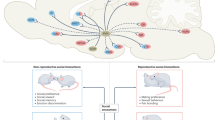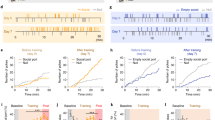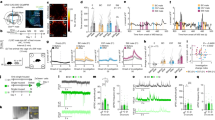Abstract
Social behaviours in species as diverse as honey bees and humans promote group survival but often come at some cost to the individual. Although reinforcement of adaptive social interactions is ostensibly required for the evolutionary persistence of these behaviours, the neural mechanisms by which social reward is encoded by the brain are largely unknown. Here we demonstrate that in mice oxytocin acts as a social reinforcement signal within the nucleus accumbens core, where it elicits a presynaptically expressed long-term depression of excitatory synaptic transmission in medium spiny neurons. Although the nucleus accumbens receives oxytocin-receptor-containing inputs from several brain regions, genetic deletion of these receptors specifically from dorsal raphe nucleus, which provides serotonergic (5-hydroxytryptamine; 5-HT) innervation to the nucleus accumbens, abolishes the reinforcing properties of social interaction. Furthermore, oxytocin-induced synaptic plasticity requires activation of nucleus accumbens 5-HT1B receptors, the blockade of which prevents social reward. These results demonstrate that the rewarding properties of social interaction in mice require the coordinated activity of oxytocin and 5-HT in the nucleus accumbens, a mechanistic insight with implications for understanding the pathogenesis of social dysfunction in neuropsychiatric disorders such as autism.
This is a preview of subscription content, access via your institution
Access options
Subscribe to this journal
Receive 51 print issues and online access
$199.00 per year
only $3.90 per issue
Buy this article
- Purchase on Springer Link
- Instant access to full article PDF
Prices may be subject to local taxes which are calculated during checkout






Similar content being viewed by others
References
Kelley, A. E. & Berridge, K. C. The neuroscience of natural rewards: relevance to addictive drugs. J. Neurosci. 22, 3306–3311 (2002)
Insel, T. R. Is social attachment an addictive disorder? Physiol. Behav. 79, 351–357 (2003)
Shultz, S., Opie, C. & Atkinson, Q. D. Stepwise evolution of stable sociality in primates. Nature 479, 219–222 (2011)
Young, L. J. & Wang, Z. The neurobiology of pair bonding. Nature Neurosci. 7, 1048–1054 (2004)
Lee, H.-J., Macbeth, A. H., Pagani, J. H. & Young, W. S. Oxytocin: the great facilitator of life. Prog. Neurobiol. 88, 127–151 (2009)
Ross, H. E. et al. Characterization of the oxytocin system regulating affliative behavior in female prairie voles. Neurosci. 162, 892–903 (2009)
Yamasue, H. et al. Integrative approaches utilizing oxytocin to enhance prosocial behavior: from animal and human social behavior to autistic social dysfunction. J. Neuroscience 32, 14109–14117 (2012)
Anderson, P. K. & Hill, J. Mus musculus: experimental induction of territory formation. Science 148, 1753–1755 (1965)
Riedman, M. L. The evolution of alloparental care and adoption in mammals and birds. Q. Rev. Biol. 57, 405–435 (1982)
Holy, T. E. & Guo, Z. Ultrasonic songs of male mice. PLoS Biol. 3, e386 (2005)
Panksepp, J. Behavior. Empathy and the laws of affect. Science 334, 1358–1359 (2011)
Hodgson, S. R., Hofford, R. S., Roberts, K. W., Wellman, P. J. & Eitan, S. Socially induced morphine pseudosensitization in adolescent mice. Behav. Pharmacol. 21, 112–120 (2010)
Tzschentke, T. M. Measuring reward with the conditioned place preference (CPP) paradigm: update of the last decade. Addict. Biol. 12, 227–462 (2007)
Panksepp, J. B. & Lahvis, G. P. Social reward among juvenile mice. Genes Brain Behav. 6, 661–671 (2007)
Rosen, G. J., de Vries, G. J., Goldman, S. L., Goldman, B. D. & Forger, N. G. Distribution of oxytocin in the brain of a eusocial rodent. Neuroscience 155, 809–817 (2008)
Hermes, M. L., Buijs, R. M., Masson-Pévet, M. & Pévet, P. Oxytocinergic innervation of the brain of the garden dormouse (Eliomys quercinus L.). J. Comp. Neurol. 273, 252–262 (1988)
Phillipson, O. T. & Griffiths, A. C. The topographic order of inputs to nucleus accumbens in the rat. Neuroscience. 16, 275–296 (1985)
Brog, J. S., Ongse, A. S., Deutch, A. Y. & Zahm, D. S. The patterns of afferent innervation of the core and shell in the “accumbens” part of the rat ventral striatum: immunohistochemical detection of retrogradely transported fluoro-gold. J. Comp. Neurol. 278, 255–278 (1993)
Knobloch, H. S. et al. Evoked axonal oxytocin release in the central amygdala attenuates fear response. Neuron 73, 553–566 (2012)
Lobo, M. K. & Nestler, E. J. The striatal balancing act in drug addiction: distinct roles of direct and indirect pathway medium spiny neurons. Front. Neuroanat. 5, 41 (2011)
Shuen, J. A., Chen, M., Gloss, B. & Calakos, N. Drd1a-tdTomato BAC transgenic mice for simultaneous visualization of medium spiny neurons in the direct and indirect pathways of the basal ganglia. J. Neurosci. 28, 2681–2685 (2008)
Gong, S. et al. A gene expression atlas of the central nervous system based on bacterial artificial chromosomes. Nature 425, 917–925 (2003)
Yoshida, M. et al. Evidence that oxytocin exerts anxiolytic effects via oxytocin receptor expressed in serotonergic neurons in mice. J. Neurosci. 29, 2259–2271 (2009)
Lee, H.-J., Caldwell, H. K., Macbeth, A. H., Tolu, S. G. & Young, W. S. A conditional knockout mouse line of the oxytocin receptor. Endocrinology 149, 3256–3263 (2008)
Brunner, D., Buhot, M. C., Hen, R. & Hofer, M. Anxiety, motor activation, and maternal-infant interactions in 5HT1B knockout mice. Behav. Neurosci. 113, 587–601 (1999)
Furay, A. R., McDevitt, R. A., Miczek, K. A. & Neumaier, J. F. 5–HT1B mRNA expression after chronic social stress. Behav. Brain Res. 224, 350–357 (2011)
Orabona, G. M. et al. HTR1B and HTR2C in autism spectrum disorders in Brazilian families. Brain Res. 1250, 14–19 (2009); erratum. 1264, 127 (2009)
Mathur, B. N., Capik, N. A., Alvarez, V. A. & Lovinger, D. M. Serotonin induces long-term depression at corticostriatal synapses. J. Neurosci. 31, 7402–7411 (2011)
Cui, G. et al. Concurrent activation of striatal direct and indirect pathways during action initiation. Nature 494, 238–242 (2013)
Capper-Loup, C., Canales, J. J., Kadaba, N. & Graybiel, A. M. Concurrent activation of dopamine D1 and D2 receptors is required to evoke neural and behavioral phenotypes of cocaine sensitization. J. Neurosci. 22, 6218–6227 (2002)
Nambu, A. Seven problems on the basal ganglia. Curr. Opin. Neurobiol. 18, 595–604 (2008)
Perreault, M. L., Hasbi, A., O’Dowd, B. F. & George, S. R. The dopamine d1-d2 receptor heteromer in striatal medium spiny neurons: evidence for a third distinct neuronal pathway in Basal Ganglia. Front. Neuroanat. 5, 31 (2011)
Doya, K. Metalearning and neuromodulation. Neural Netw. 15, 495–506 (2002)
Nakamura, K., Matsumoto, M. & Hikosaka, O. Reward-dependent modulation of neuronal activity in the primate dorsal raphe nucleus. J. Neurosci. 28, 5331–5343 (2008)
Tanaka, S. C. et al. Prediction of immediate and future rewards differentially recruits cortico-basal ganglia loops. Nature Neurosci. 7, 887–893 (2004)
Boureau, Y.-L. & Dayan, P. Opponency revisited: competition and cooperation between dopamine and serotonin. Neuropsychopharmacology 36, 74–97 (2011)
Silverman, J. L., Yang, M., Lord, C. & Crawley, J. N. Behavioural phenotyping assays for mouse models of autism. Nature Rev. Neurosci. 11, 490–502 (2010)
Panksepp, J. B. et al. Affiliative behavior, ultrasonic communication and social reward are influenced by genetic variation in adolescent mice. PLoS ONE 2, e351 (2007)
Aronov, D., Andalman, A. S. & Fee, M. S. A specialized forebrain circuit for vocal babbling in the juvenile songbird. Science 320, 630–634 (2008)
Andalman, A. S. & Fee, M. S. A basal ganglia-forebrain circuit in the songbird biases motor output to avoid vocal errors. Proc. Natl Acad. Sci. USA 106, 12518–12523 (2009)
Mebatsion, T., Konig, M. & Conzelmann, K. K. Budding of rabies virus particles in the absence of the spike glycoprotein. Cell 84, 941–951 (1996)
Wickersham, I. R., Sullivan, H. A. & Seung, H. S. Production of glycoprotein-deleted rabies viruses for monosynaptic tracing and high-level gene expression in neurons. Nature Protocols 5, 595–606 (2010)
Wickersham, I. R., Finke, S., Conzelmann, K. & Callaway, E. M. Retrograde neuronal tracing with a deletion-mutant rabies virus. Nature Methods 4, 47–49 (2007)
Grimm, D. et al. In vitro and in vivo gene therapy vector evolution via multispecies interbreeding and retargeting of adeno-associated viruses. J. Virol. 82, 5887–5911 (2008)
Lammel, S. et al. Input-specific control of reward and aversion in the ventral tegmental area. Nature 491, 212–217 (2012)
Ben-Barak, Y., Russell, J., Whitnall, M., Ozato, K. & Gainer, H. Neurophysin in the hypothalamo-neurohypophysial system. I. Production and characterization of monoclonal antibodies. J. Neurosci. 5, 81–97 (1985)
Whitnall, M. H. Key. S., Ben-Barak, Y., Ozato, K. & Gainer, H. Neurophysin in the hypothalamo-neurohypophysial system. II. Immunocytochemical studies of the ontogeny of oxytocinergic and vasopressinergic neurons. J. Neurosci. 5, 98–109 (1985)
Acknowledgements
We thank members of the Malenka laboratory for comments; A. Andalman, W. Xu, B.K. Lim and T. Sudhof for technical advice; and the SIM1 Animal Care facility for husbandry support. The OT-neurophysin antibody was a gift of H. Gainer. OTR-Venus reporter mice were a gift of L. J. Young. D1-TdTomato BAC transgenic mice were provided by N. Calakos. The rabies virus complementary DNA plasmid and viral component-expressing plasmids were gifts from K. Conzelmann and I. Wickersham. HHK-B19G cells were a gift from E. Callaway. AAVs were produced by the Stanford NGVVC (supported by National Institutes of Health grant NIH NS069375). The AAV-DJ helper plasmid was a gift from M. Kay. This work was supported by funding from the Simons Foundation Autism Research Initiative (R.C.M.), N.I.H. (R.C.M.), and a Berry Foundation Postdoctoral Fellowship (G.D.)
Author information
Authors and Affiliations
Contributions
G.D. and R.C.M. designed the study, interpreted results and wrote the paper. G.D. performed behavioural experiments, electrophysiology, and confocal microscopy. G.D., A.D. and K.W.H. performed stereotaxic injections and immunohistochemistry. K.W.H. generated RBV viruses. All authors edited the paper.
Corresponding author
Ethics declarations
Competing interests
The authors declare no competing financial interests.
Supplementary information
Supplementary Figures
This file contains Supplementary Figures 1-16. (PDF 2038 kb)
Rights and permissions
About this article
Cite this article
Dölen, G., Darvishzadeh, A., Huang, K. et al. Social reward requires coordinated activity of nucleus accumbens oxytocin and serotonin. Nature 501, 179–184 (2013). https://doi.org/10.1038/nature12518
Received:
Accepted:
Published:
Issue Date:
DOI: https://doi.org/10.1038/nature12518
This article is cited by
-
Involvement of the ipsilateral-to-the-pain anterior–superior hypothalamic subunit in chronic cluster headache
The Journal of Headache and Pain (2024)
-
Therapeutic mechanisms of psychedelics and entactogens
Neuropsychopharmacology (2024)
-
Synchronized LFP rhythmicity in the social brain reflects the context of social encounters
Communications Biology (2024)
-
From Parental Behavior to Sexual Function: Recent Advances in Oxytocin Research
Current Sexual Health Reports (2024)
-
Maturation of nucleus accumbens synaptic transmission signals a critical period for the rescue of social deficits in a mouse model of autism spectrum disorder
Molecular Brain (2023)
Comments
By submitting a comment you agree to abide by our Terms and Community Guidelines. If you find something abusive or that does not comply with our terms or guidelines please flag it as inappropriate.



